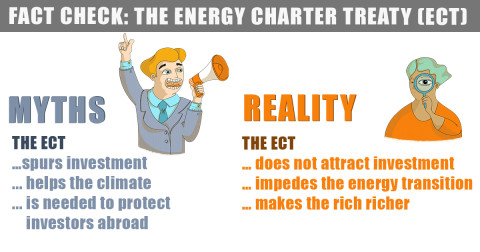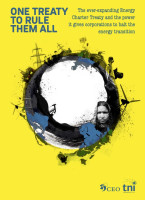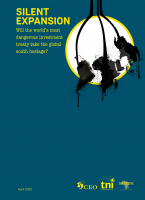Busting the myths around the Energy Charter Treaty A guide for concerned citizens, activists, journalists and policymakers
Amidst growing concerns that the Energy Charter Treaty (ECT) undermines urgent climate action, and a growing backlash against the treaty, its profiteers are spewing propaganda, promoting falsehoods about how the ECT attracts clean investment and how its 'modernisation' will fix any flaws. Cut through their rhetoric with our new myth-busting guide.

Descargas
Autores

Opposition to the ECT is growing rapidly. In October 2020, the European Parliament voted to end the ECT’s protection for fossil fuels. In November, 280 parliamentarians called on the European Commission and EU members to “explore pathways to jointly withdraw”. In December, over 200 climate leaders and scientists echoed that demand calling the ECT “a major obstacle” to the clean energy transition. Behind the scenes in the Council, EU member states like France, Spain, and Luxembourg, too, have raised the withdrawal option if the ECT cannot conform to the Paris Climate Agreement. Belgium has even asked the European Court of Justice if the ECT is at all in line with EU law.
But powerful interests are gearing up to defend the treaty – and even expand it to new signatory states, particularly in Africa, Asia and Latin America. These interests include the fossil fuels lobby, which is keen to keep its powerful legal privileges; lawyers, who make millions arguing ECT cases; the ECT Secretariat, which has close ties to both industries and whose survival depends on continuation of the treaty – and the list goes on.
This guide aims to help activists, concerned citizens, journalists and policymakers confront pro-ECT propaganda. It identifies the ECT’s defenders and their arguments, and offers deeply researched counter-evidence to the following claims:
- Claim 1: The ECT increases foreign investment
- Claim 2: The ECT promotes the rule of law
- Claim 3: The ECT is the only way to protect energy investors abroad, particularly in countries with weak judicial systems
- Claim 4: States win the majority of ECT cases
- Claim 5: Investors win much less money than they claim
- Claim 6: The ECT is most often used by small and medium-sized enterprises (SMEs)
- Claim 7: Thanks to the ECT more capital will flow into clean energy
- Claim 8: The ECT does not favour fossil fuels – it protects all types of energy equally
- Claim 9: The ECT protects the climate by holding governments accountable to their commitments on renewable energy
- Claim 10: Many renewable energy investors have been harmed in Spain – and elsewhere – and the ECT is the only way for them to get justice
- Claim 11: Modernisation will bring the ECT in line with climate goals
- Claim 12: Integrating states’ ‘right to regulate’ in the ECT will shield public policies from investor lawsuits
- Claim 13: The modernisation will bring the ECT in line with EU investment policy
- Claim 14: Leaving the ECT is not an option as any country that leaves risks being sued for more years – so it’s better to engage
- Claim 15: We cannot abandon the ECT because we need to uphold multilateralism
- Claim 16: The ECT brings access to modern energy services and reduces energy poverty
- Claim 17: Joining the ECT allows countries to have a say on global energy issues
- Claim 18: It is presumptuous for NGOs to tell countries that they shouldn’t join the ECT



